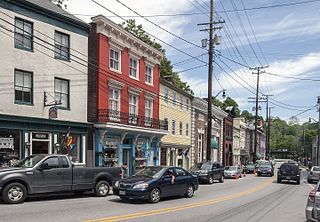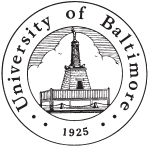
Maryland is a state in the Mid-Atlantic region of the United States. The state borders Virginia to its south, West Virginia to its west, Pennsylvania to its north, Delaware to its east, the Atlantic Ocean, and the national capital of Washington, D.C. With a total area of 12,407 square miles (32,130 km2), Maryland is the ninth-smallest state by land area, and its population of 6,177,224 ranks it the 18th-most populous state and the fifth-most densely populated. Maryland's capital is Annapolis, and the most populous city is Baltimore. Occasional nicknames include Old Line State, the Free State, and the Chesapeake Bay State. It is named after Henrietta Maria, the French-born queen of England, Scotland, and Ireland during the 17th century.

Howard County is located in the U.S. state of Maryland. As of the 2020 census, the population was 334,529. Since there are no incorporated municipalities, there is no incorporated county seat either. Therefore, its county seat is the unincorporated community of Ellicott City. Howard County is included in the Baltimore-Columbia-Towson, MD Metropolitan Statistical Area, which is part of the larger Washington–Baltimore combined statistical area.

The University of Baltimore is a public university in Baltimore, Maryland. It is part of the University System of Maryland. UBalt's schools and colleges provide education in business, law, public affairs, and the applied arts and sciences. The university is the location of one of Maryland's two law schools.

Baltimore City College, known colloquially as City, City College, and B.C.C., is a college preparatory school with a liberal arts focus and selective admissions criteria located in Baltimore, Maryland. Opened in October 1839, B.C.C. is the third-oldest active public high school in the United States. City College is a public exam school and an International Baccalaureate World School at which students in the ninth and tenth grades participate in the IB Middle Years Programme while students in the eleventh and twelfth grades participate in the IB Diploma Programme.
The Howard County Public School System (HCPSS) is the school district that manages and runs the public schools of Howard County, Maryland. It operates under the supervision of an elected, eight-member Board of Education. Jennifer Mallo is the chair of the board. William J. Barnes has been the acting superintendent since January 2024.

Hamilton Hills is a mixed-use suburban neighborhood located in the northeastern corner of Baltimore City, Maryland. Hamilton Hills represents a section of Hamilton, a larger historic area that includes other neighborhoods in Northeast Baltimore. The neighborhood's borders are Old Harford Road and Harford Road to the east, Echodale Avenue to the south, Perring Parkway to the west and the Baltimore County line to the north. The main thoroughfare in Hamilton Hills is Harford Road, which has been an integral part of the area's history.

Doris M. Johnson High School was a public high school located in the northeast area known as Clifton Park of Baltimore, Maryland.

Baltimore Freedom Academy (BFA) was a Baltimore City middle-high school, located for most of its existence in the Washington Hill neighborhood. Founded in 2003 as a public "innovation school," beginning in 2008 it operated as a charter school. The school was open to students citywide through the Baltimore City Public Schools lottery system. Baltimore Freedom Academy was closed by Baltimore City Public Schools following the 2013 school year.
Baltimore County Public Schools is the school district in charge of all public schools in Baltimore County, Maryland, United States. It is the 25th largest school system in the US as of 2013. The school system is managed by the board of education, headquartered in Towson. Since July 1, 2023, the superintendent is Myriam Rogers.

Patterson High School is a public high school located in the Hopkins-Bayview neighborhood in Baltimore, Maryland, United States.

Achievement Academy, officially Achievement Academy at Harbor City High School, is a public alternative high school located in Baltimore, Maryland, United States. The school currently resides in the former Northern High School campus, at 2201 Pinewood Avenue. Achievement Academy is an alternative school program operated by Baltimore City Public Schools to serve students with severe academic and/or behavior issues.

Adrienne Alease Jones is an American politician who has served as the 107th Speaker of the Maryland House of Delegates since 2019. A member of the Democratic Party, she is the first African-American and first woman to serve in that position in Maryland. She has represented District 10 in the Maryland House of Delegates since 1997.
Desegregation of the Baltimore City Public Schools took place in 1956 after the United States Supreme Court ruled, in the case of Brown v. Board of Education, that segregation in schools went against constitutional law. Desegregation of U.S. schools was part of the civil rights movement. The events that followed desegregation in Baltimore, were important to the civil rights movement across America. Recent scholarship has identified Baltimore's desegregation as an important precursor to the Greensboro sit-ins.
Andrés Alonso was the chief executive officer of the Baltimore City Public School System in Baltimore, Maryland, United States. Alonso came to Baltimore from the New York City Public School system in July 2007. He had been deputy chancellor in New York for the year prior to his appointment in Baltimore.

Baltimore is the most populous city in the U.S. state of Maryland. With a population of 585,708 at the 2020 census, it is the 30th-most populous city in the United States. Baltimore was designated an independent city by the Constitution of Maryland in 1851, and is currently the most populous independent city in the nation. As of the 2020 census, the population of the Baltimore metropolitan area was 2,838,327, the 20th-largest metropolitan area in the country. When combined with the larger Washington metropolitan area, the Washington–Baltimore combined statistical area (CSA) has a 2020 U.S. census population of 9,973,383, the third-largest in the country.

The Baldwin County Board of Education oversees most public schools in Baldwin County, Alabama, and is based in Bay Minette, Alabama. The Board serves the entire county. Over 30,000 students are within the supervision of the Board. 3,400 employees including 2,100 classroom teachers, serve the students at its campuses. The Board of Education is the largest single employer in Baldwin County.

Calvin B. Ball III is an American politician who serves as the county executive of Howard County, Maryland. A member of the Democratic Party, he is the first African-American to hold this office. He previously served as a member of the Howard County Council from the 2nd district from 2006 to 2018.

Brandon Maurice Scott is an American politician serving as the mayor of Baltimore, Maryland, since 2020. The city of Baltimore uses a strong mayor-council structure for their government, meaning Scott holds strong mayoral powers. He is the former president of the Baltimore City Council and was a candidate for lieutenant governor of Maryland in 2018, as well as a representative for Baltimore's second district. On May 6, 2019, Scott was elected to replace Jack Young as council president after Young succeeded Mayor Catherine Pugh. In September 2019, Scott announced his candidacy for mayor and won the June 2020 Democratic primary. Scott won the November 3 general election and took office on December 8, 2020.
City Neighbors High School is a public charter high school located in the Glenham-Benhar neighborhood of Baltimore, Maryland, United States. Opened in 2010, City Neighbors High was the third school launched by the larger City Neighbors Foundation program, a Baltimore-based charter organization. The school operates as a non-profit 501(c)(3) corporation under the name "City Neighbors High School Inc."

Andrew Christopher Pruski is an American politician. He is a member of the Maryland House of Delegates for District 33A in Anne Arundel County, Maryland. He was previously a member of the Anne Arundel County Council from 2014 to 2022, serving as its chair from 2018 to 2019 and its vice-chair from 2021 to 2022.


















